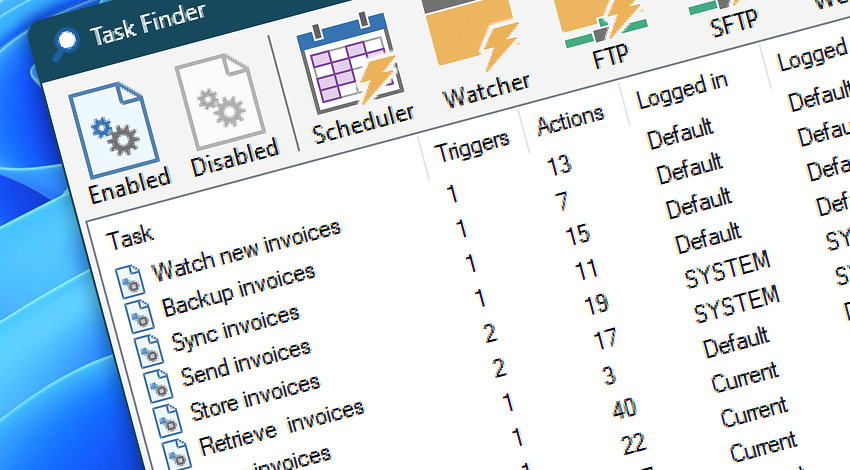

Set the properties for the FileSystemWatcher.įsWatch.Changed += new FileSystemEventHandler(LogFile) įsWatch.Created += new FileSystemEventHandler(LogFile) įsWatch.Deleted += new FileSystemEventHandler(LogFile) įsWatch.Renamed += new RenamedEventHandler(LogRename) įileSystemEventHandler(AddressOf LogFile) VB.NET Private fsWatch As FileSystemWatcher Name them anything you like, but keep in mind that my names may differ from yours.Īdd the following namespaces to your code. Two textboxes with their Text properties set.Once your form has loaded, design it to resemble Figure 1.
#Filewatcher s3 windows#
Open Visual Studio 2019 and create either a new C# or VB.NET Windows Forms application. These changes could be things like file deletion, file renaming, changing the properties of a file, and so on. To put it better: It watches a folder for any changes.

What Is FileSystemWatcher?Īs the name implies, it watches the system for files. Today, I would like to talk about using the FileSystemWatcher in.
#Filewatcher s3 code#
If you like the module and want to see more you may inspect or fork its code at GitHub.Welcome to my article. Piping the filesystem watchers also works with the other commands. Get-FileSystemWatcher | Remove-FileSystemWatcher Remove-FileSystemWatcher -SourceIdentifier "MyEvent" Finally, if you want get rid of filesystem watchers the command Remove-FileSystemWatcher disposes a filesystem watcher specified by the source identifier or by piping in a collection of watchers: # to dispose one watcher

This command writes a state object to the pipe containing the configuration of all filesystem watchers. NotifyFilter : FileName, DirectoryName, LastWrite To keep track of all the filesystem watchers created in the current PowerShell process, you can use the command Get-FileSystemWatcher: PS> Get-FileSystemWatcher Resume-FileSystemWatcher -SourceIdentifier "MyEvent" To suspend the notification temporarily and to resume it later the following two commands can be used: Suspend-FileSystemWatcher -SourceIdentifier "MyEvent" "TimeGenerated": "T21:39:50.4483088+01:00",Įvents raised before a handler is registered remain in the queue until you consume them using Get-Event/ Remove-Event. To produce a new event, just write some characters to a file in the watched directory: PS> "XYZ" > C:\Tempfilesxyz PowerShell allows you to register more than one handler for a single source identifier but the FSWatcherEngineEvent module doesn’t allow you to create more than one watcher using the same source identifier. Id Name PSJobTypeName State HasMoreData Location Commandġ MyEvent NotStarted False |ConvertTo-Json|Wr… The following example just writes the whole event converted to JSON to the console: PS> Register-EngineEvent -SourceIdentifier "MyEvent" -Action You can consume the event by registering an event handler for the same source identifier. The watcher now sends notifications to PowerShell’s engine event queue using the source identifier “MyEvent”. New-FileSystemWatcher -SourceIdentifier "MyEvent" -Path C:\Tempfiles Please refer to the Microsoft’s reference documentation of the FileSystemWatcher class for the details.

#Filewatcher s3 install#
It hides the C#-API behind a PowerShell command with argument completion, it keeps track of the created watchers, and provides commands to pause notifications and to clean up the watchers if they are no longer needed.Īfter you install and import the module, you can create a new filesystem watcher. I made the FSWatcherEngineEvent PowerShell module to make these file system watchers easier to use.
#Filewatcher s3 how to#
There are already many examples on the internet showing how to create and configure the watcher in PowerShell but this isn’t something I can easily recall from memory at the moment I need it. A file system watcher listens to change notifications generated by the operating system and invokes a given function if the file change matches several filter criteria like the directory, the file name or the type of the change. NET Framework class named FileSystemWatcher which suits this job perfectly. Some time ago I wanted to sync files from a source directory to a destination directory immediately after they had changed in the source directory.


 0 kommentar(er)
0 kommentar(er)
